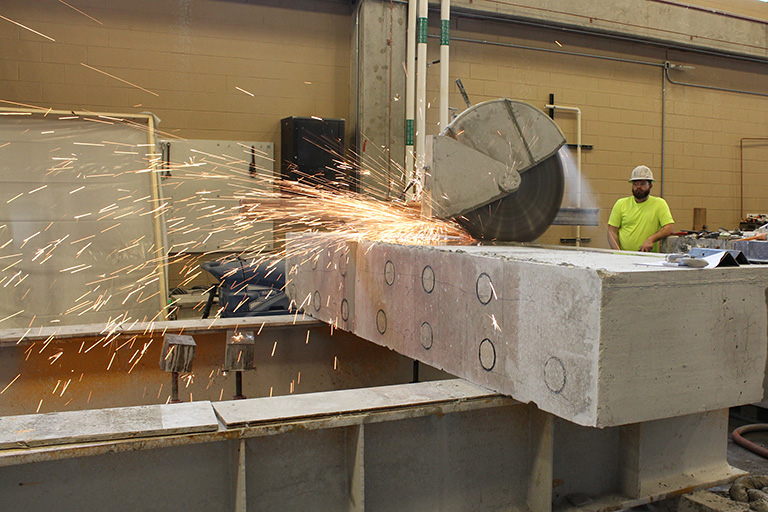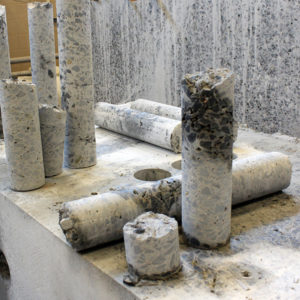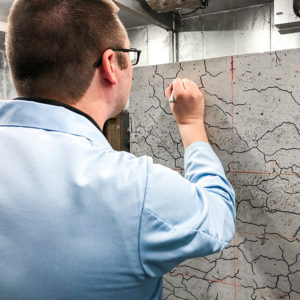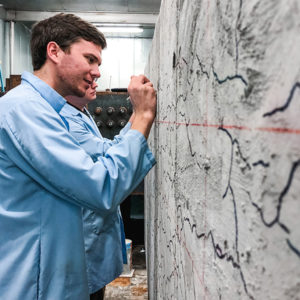John Ma’s Massive Concrete for Nuclear Applications Research Project Enters its Final Phase

James Smith from Cuts, Inc., saws through a concrete structure in preparation for load testing.
Highlights
- Alkali Silica Reactions are considered “cancer” for concrete.
- Professor John Ma is exploring how they form.
- His work could lead to stronger materials for nuclear energy applications.
The failure of concrete in any form of construction is troubling enough, but add in the ‘failure-is-not-an-option’ component of nuclear energy, and the need for reliable materials increases tenfold.
Professor John Ma, of UT’s Department of Civil and Environmental Engineering, is seeking to remedy that problem before it even starts, thanks to a multi-year project now entering its final phase.
—John Ma
Ma’s study involves the degradation of concrete through Alkali Silica Reactions (ASR), also known as the “cancer” of concrete.
During these reactions, concrete forms a gel that absorbs water. As it expands, it damages concrete over time, both on the surface and within structures. By understanding how ASR works, the strengths of existing reactors and their safety can be monitored and outcomes better predicted.
For his study, Ma rigged a number of samples with different components to see which method worked the best, including placing rebar along the outside and embedding the concrete with acoustic emission and pressure sensors, fiber optics, and transducers that convert physical changes into electrical signals.
Steel reinforcement layers were designed for the top and bottom of each specimen, so as to leave the entire thickness without shear reinforcement.
He then set up two samples with different boundaries, allowing one to grow unimpeded while the other was constrained.
ASR was accelerated by maintaining the samples at 95 percent humidity and 100 degrees Fahrenheit. ASR was further accelerated in two of the specimen by the addition of sodium hydroxide to the mix, while lithium nitrate was used in the control mix formulation.
Once the samples entered this final phase after years of being subjected to test conditions, the temperature-controlled chamber—that was specially designed for this study—was removed and the three test structures were cut into both beams and wall elements.
- Cylinders of concrete were removed with a coring drill for load tests to measure the strength inside the concrete specimens.
- CEE graduate student Nolan Hayes measures and records the cracks formed by ASR.
- CEE graduate student Matthew Lyons measures and records the cracks formed by ASR.
In the coming months, the beams will be subjected to a three-point load test, while the shear walls will be put through quasi-static loading to measure the shear capacity of different elements.
Additionally, with the chamber gone, the team was able to remove cylinders of concrete, which will help identify the behavior of the concrete in different directions. All of the tests contribute to a greater understanding of concrete’s behavior under different circumstances.
The experiment—thought to be the first of its kind at this scale and with so many monitoring sensors—will wrap up in September and will provide a better understanding of the effect of geometrical conditions and preexisting ASR cracks.
The specific purpose of the project is to provide insight for the nuclear industry in managing aging infrastructure, with Oak Ridge National Laboratory and a consortium of other universities including the University of Alabama, the University of South Carolina, and Vanderbilt University serving as partners.
While this study is focused on the nuclear industry, it will also provide far-reaching understanding into the behavior of concrete across other industries.
For more details about Ma’s concrete research project, watch the below video.
Contact
Élan Young: elan@tennessee.edu


